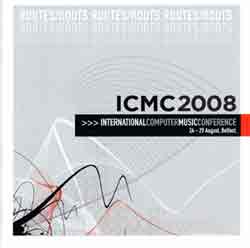TEXTS (2008)(Edit)
Publishings/Publications : — Biblio — — Texts List — — 2013 — 2012 — 2011 — 2010 — 2009 — 2008 — 2007-2004 —
| To download texts : http://jeromejoy.org/files/txt/ (Pour télécharger l'intégralité des textes) | ....................... Academia.edu : http://ulaval.academia.edu/JeromeJoy/Papers |
2008(Edit)
| | ||
| | ||
|
Joy J. Sinclair P. (2008). Networked Sonic Spaces (Les Espaces Sonores en Réseau) In GlobalWare Corporation (Ed.) Roots/Routes, International Computer Music Conference ICMC’08 (Panel : « Networking Performance » ; Andrew Gerszo, Georg Hadju, Pauline Oliveros, Robert Rowe, Jonas Braasch, Chris Chafe, Pedro Rebelo, Alain Renaud, Gualterio Volpe, Winfried Ritsch, Andrea Cera, Miller Puckette, Peter Sinclair, Jerome Joy) (pp. 553-555). Belfast : SARC, Sonic Art Research Center, Queens University, & International Computer Music Association ICMA (Publishers). Le laboratoire de recherche en art Locus Sonus travaille depuis son lancement en 2004 sur les enjeux croisés entre audio en espace et audio en réseau. Les premiers projets (Locustream, Wimicam) ont été développés et réalisés à partir d'expérimentations des techniques de streaming engageant les problématiques des pratiques des flux en espace et en réseau (local/remote, sympathies, résonances, mixed realities). Deux axes constituent notre recherche actuelle et nos réalisations artistiques en cours : Field Spatialization et Networked Sonic Spaces. Cette recherche est basée sur la création d'un corpus d'expérimentations artistiques et techniques et sur une méthodologie dirigée par la pratique (practice-led) et orientée sur la réalisation artistique publique (expérimentation contrôlée). Notre proposition s’appuie sur une mise à jour d’un champ expérimental situé aux intersections et dans les apports respectifs des domaines artistiques plastiques et musicaux. Au cœur de cet espace de recherche et d'expérimentation la notion couplée « son / espace » (l'espace problématisé par le son et vice-versa) est la rotule essentielle de nos investigations. Celles-ci proposent un éventail de propositions, allant de la performance et du concert aux installations, en passant par toutes les modalités et opérations de restitution et de diffusion acoustique et électroacoustique, de mises en place de systèmes, d’appareils et de dispositifs (lutheries, programmes, interfaces, publics, audiences), ou encore d'actions et de processus en direct jouables et interprétables (performances, compositions, im- et com-provisations, etc.). La mise en œuvre principale du laboratoire concerne les transports des sons (et des ambiances) donnant lieu à la construction de dispositifs de streaming et d'environnements sensoriels et expérientiels (constituant des dispositions et des types d'écoute), synchrones et asynchrones, locaux, distants et situés, autophones et chronotopes : les espaces sonores en réseau. — Since it was launched in 2004, the research group Locus Sonus has been working on artistic possibilities arising from the intersection of networked and acoustic or local audio spaces. The first projects, Locustream & Wimicam, were developed from experimentation using audio streaming techniques, and engage with problematic related to the use of flux for artistic purposes (flux understood here as a continually updating medium) in local and networked environments. Today our research is grouped under two main headings Field Spatialization and Networked Sonic Spaces. Our research is fundamentally practice based aiming to create a corpus of artistic experimentation around a common problematic. The forms emanating from this activity are « verified » essentially through their presentation in public contexts. The choice of implementing this research within the art education environment is prompted by the current renewal of techniques and art-forms which are at the intersection of the visual arts and music. The marriage of sound and space (sound problematized by space and visa versa) is at the heart of our research and experimentation, the main pivot of our investigations. A number of different forms are experimented within the group, ranging from concert/performance, through installation to web-based projects. The elaboration of these different types of proposition implies the development of appropriate systems for the restitution and diffusion of acoustic and electronic sound, of apparatus and devices such as instruments, computer programs, interfaces and the invention of processes, protocols and concepts. The main part of our current investigation concerns the transport of sound (and sound ambiances) which has lead to the construction of streaming systems as well as sensorial and experiential environments which favour different listening experiences, synchronous and asynchronous, local, distant, geographically identified, « autophone » and « chronotope »: the networked sonic spaces. [ ... → continue reading — lire l'article ... ] [ ... → pdf download (English version) — télécharger le pdf ... ] [ ... → pdf download (French version) — télécharger le pdf ... ] |
 | |
Publishings/Publications : — Biblio — — Texts List — — 2013 — 2012 — 2011 — 2010 — 2009 — 2008 — 2007-2004 —